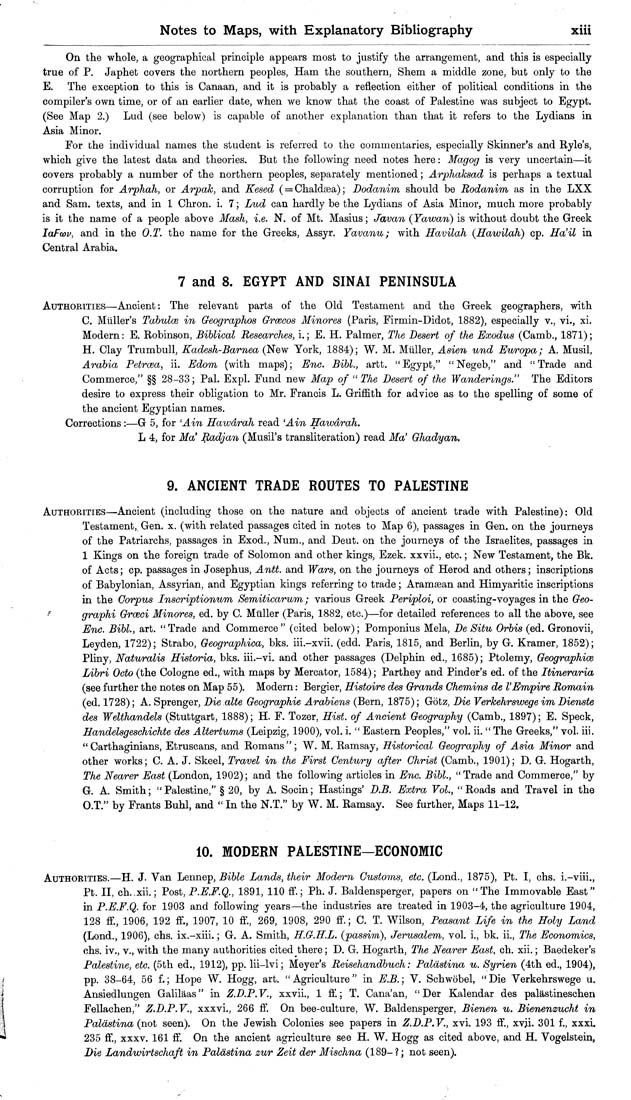Notes to Maps, with Explanatory Bibliography xiii
On the whole, a geographical principle appears most to justify the arrangement, and this is especially
true of P. Japhet covers the northern peoples. Ham the southern, Shem a middle zone, but only to the
E. The exception to this is Canaan, and it is probably a reflection either of political conditions in the
compiler's own time, or of an earlier date, when we know that the coast of Palestine was subject to Egypt.
(See Map 2.) Lud (see below) is capable of another explanation than that it refers to the Lydians in
Asia Minor.
For the individual names the student is referred to the commentaries, especially Skinner*s and Ryle's,
which give the latest data and theories. But the following need notes here: Magog is very uncertain—it
covers probably a number of the northern peoples, separately mentioned; Arphaksad is perhaps a textual
corruption for Arphah, or Arpak, and Kesed ( = Chald8ea); Dodanim should be Rodanim as in the LXX
and Sam. texts, and in 1 Chron. i. 7; Lud can hardly be the Lydians of Asia Minor, much more probably
is it the name of a people above Mash, i.e. N. of Mt. Masius; Javan (Yawan) is without doubt the Greek
laFcov, and in the O.T. the name for the Greeks, Assyr. Yavanu; with Havilah (Hawilah) cp. Hail in
Central Arabia.
7 and 8. EGYPT AND SINAI PENINSULA
Authorities—Ancient: The relevant parts of the Old Testament and the Greek geographers, with
C. Miiller's Tabulce in Geographos Grcecos Minores (Paris, Firmin-Didot, 1882), especially v., vi., xi.
Modern: E. Robinson, Biblical Researches, i.; E. H. Palmer, The Desert of the Exodus (Camb., 1871);
H. Clay Trumbull, Kadesh-Barnea (New York, 1884); W. M. Muller, Asien und Europa; A. Musil,
Arabia Petroea, ii. Edom (with maps); Enc. Bibl., artt. "Egypt," "Negeb," and "Trade and
Commerce," §§ 28-33; Pal. Expl. Fund new Map of " The Desert of the Wanderings.'' The Editors
desire to express their obligation to Mr. Francis L. Griffith for advice as to the spelling of some of
the ancient Egyptian names.
Corrections:—G 5, for 'Ain Hawdrah read 'Ain Hawdrah.
L 4, for Ma* Radjan (Musil's transliteration) read Ma' Ghadyan.
9. ANCIENT TRADE ROUTES TO PALESTINE
Authorities—Ancient (including those on the nature and objects of ancient trade with Palestine): Old
Testament, Gen. x. (with related passages cited in notes to Map 6), passages in Gen. on the journeys
of the Patriarchs, passages in Exod., Num., and Deut. on the journeys of the Israelites, passages in
1 Kings on the foreign trade of Solomon and other kings, Ezek. xxvii., etc.; New Testament, the Bk.
of Acts; cp. passages in Josephus, Antt. and Wars, on the journeys of Herod and others; inscriptions
of Babylonian, Assyrian, and Egyptian kings referring to trade; Aramaean and Himyaritic inscriptions
in the Corpus Inscriptionum SeTniticaruTn; various Greek Periploi, or coasting-voyages in the Geo-
^ graphi Greed Minores, ed. by C. Muller (Paris, 1882, etc.)—for detailed references to all the above, see
Enc. Bibl., art. ''Trade and Commerce" (cited below); Pomponius Mela, De Situ Orbis (ed. Gronovii,
Leyden, 1722); Strabo, Geographica, bks. iii.-xvii. (edd. Paris, 1815, and Berlin, by G. Kramer, 1852);
Pliny, Naturalis Historia, bks. iii.-vi. and other passages (Dolphin ed., 1685); Ptolemy, Geographic^
Libri Octo (the Cologne ed., with maps by Mercator, 1584); Parthey and Pinder's ed. of the Itineraria
(see further the notes on Map 55). Modern: Bergier, Histoire des Grands Ghemins de VEmpire Romain
(ed. 1728); A. Sprenger, Die alte Geographic Arabiens (Bern, 1875); Gotz, Die Verkehrswege im Dienste
des Welthandels (Stuttgart, 1888); H. F. Tozer, Hist, of Ancient Geography (Camb., 1897); E. Speck,
Handelsgeschichte des Altertums (Leipzig, 1900), vol. i. " Eastern Peoples,'' vol. ii.'' The Greeks,*' vol. iii.
" Carthaginians, Etruscans, and Komans "; W. M. Ramsay, Historical Geography of Asia Minor and
other works; C. A. J. Skeel, Travel in the First Century after Christ (Camb., 1901); D. G. Hogarth,
The Nearer East (London, 1902); and the following articles in Enc. Bibl., ''Trade and Commerce," by
G. A. Smith; "Palestine," § 20, by A. Socin; Hastings' D.B. Extra Vol., "Roads and Travel in the
O.T." by Frants Buhl, and " In the N.T." by W. M. Ramsay. See further, Maps 11-12.
10. MODERN PALESTINE-ECONOMIC
Authorities.—H. J. Van Lennep, Bible Lands, their Modern Customs, etc. (Lond., 1875), Pt. I, chs. i.-viii.,
Pt. n, ch..xii.; Post, P.E.F.Q., 1891, 110 ff.; Ph. J. Baldensperger, papers on "The Immovable East"
in P.E.F.Q. for 1903 and following years—the industries are treated in 1903-4, the agriculture 1904,
128 ff., 1906, 192 ff., 1907, 10 ff., 269, 1908, 290 ff.; C. T. Wilson, Peasant Life in the Holy Land
(Lond., 1906), chs. ix.-xiii.; G. A. Smith, H.G.H.L. (passim), Jerusalem, vol. i., bk. ii.. The Economics,
chs. iv., v., with the many authorities cited there; D. G. Hogarth, The Nearer East, ch. xii.; Baedeker's
Palestine, etc. (5th ed., 1912), pp. lii-lvi; Meyer's Reisehandbuch: Paldstina u. Syrien (4th ed., 1904),
pp. 38-64, 56 f.; Hope W. Hogg, art. "Agriculture" in E.B.; V. Schwobel, "Die Verkehrswege u.
Ansiedlungen Galilaas" in Z.D.P.V., xxvii., 1 ff*.; T. Cana'an, "Der Kalendar des palastineschen
Fellachen," Z.D.P.V., xxxvi., 266 ff. On bee-culture, W. Baldensperger, Bienen u. Bienenzucht in
Paldstina (not seen). On the Jewish Colonies see papers in Z.D.P.V., xvi. 193 ff., xvji. 301 f., xxxi.
235 ff., XXXV. 161 ff. On the ancient agriculture see H. W. Hogg as cited above, and H. Vogelstein,
Die Landwirtschaft in Paldstina zur Zeit der Mischna (189- ?; not seen).
|








